There are very few inventions, if any, that have had as much affect on the development of America as the 1851 Colt Navy Percussion Revolver. It was America’s first powerful, reliable, everyday carry firearm. Its genius inspired countless copies, and its design would endure not only beyond black powder, but well into the cartridge revolver era and even into the present day offerings of several companies.
There are very few companies I’d count on to reproduce something worthy of that legacy. Cimarron Firearms has once again teamed up with Pietta of Italy to create the 1851 Navy Laser Engraved revolver. True to the original, it’s fast-handling, historically accurate, and an absolute blast to shoot.
It’s difficult to overstate the popularity of the revolver originally titled the “Revolving Belt Pistol of Navy Caliber.” It would quickly become simply known as the “Colt Navy” or just “The Navy”, and would sell over a quarter of a million copies. Production included factories both in the US and in England. It would be used all over the world by militaries and civilians alike.
It spread fast. It was originally manufactured in 1850, but the world got its first look at what would be come the archetype Colt in 1851 during a London exposition. It took the entire world by storm, and took its popular name from that year.
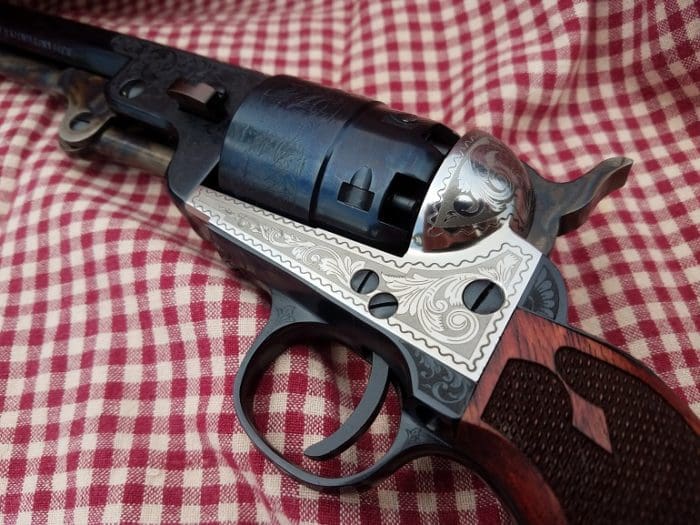
Just a year later, in 1852, the first Wells Fargo stagecoach holdup occurred in California. To accomplish this task, Reelfoot Williams and his accomplices used Colt “Navies.” These guns were made on the other side of the continent just a year before and it would be almost two decades before the transcontinental railroad would be completed. Traveling by wagon train, the pistols got “out west” fast.
“Navy caliber” refers to .36 caliber ball preferred by the United States Navy. Both the US Navy as well as the US Army issued the guns to their troops, the Army receiving the largest share. But in this case, it was the fledgling nation of Texas that took the first large orders of the Colt Navy. The government of Texas issued them in pairs to soldiers, sailors, cavalrymen, scouts and Rangers alike.
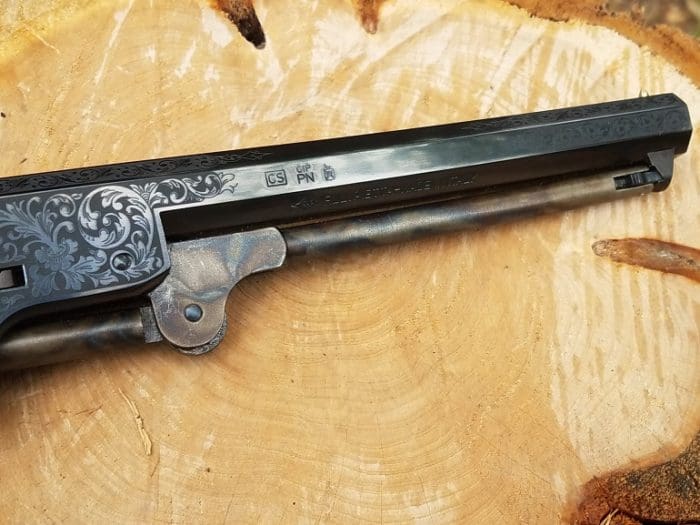
Of course, it wasn’t just the American military that was interested in the guns. Everybody loved them and used them, for good and evil alike. Mark Twain carried one and remarked that many men in California did, too, and that “every man and boy in Texas” carried at least one.
When the leader of the Pirate of the Placers gang was hung by a posse in California in 1856, he had just been relieved of his two Colt Navy revolvers. That disarmament came by way of the Placer County Sherrif, who was also carrying the same model pistol, as were members of his posse.
Wild Bill Hickok carried at least one. So did Doc Holliday, as did Robert E. Lee, and most of the Texas Rangers, for decades.
The guns were also received well on the other side of the pond, so much so that Colt set up a separate factory in London to keep up with that country’s demand. There were specific “London” models. (Oh, how the times have changed.)
Tennyson failed to name the Colt revolver in his re-telling of the Charge of the Light Brigade into the valley of Death, but these were the sidearms carried by the cavalry on that ill-fated run. The guns were even carried by the British in Africa during their eighth war against the native Xhosa tribes.
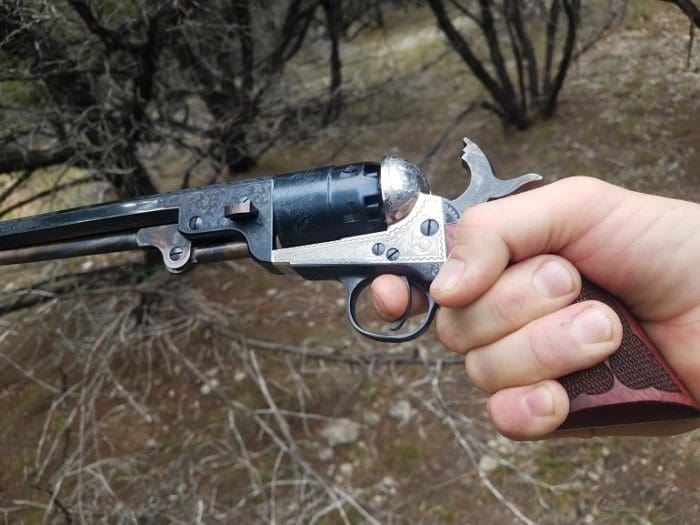
The walnut grip of this particular 1851 Navy is checkered walnut which is historically accurate for many of these guns. When you first pick up the Pietta Navy, that grip may feel a bit small. In fact, if you wear size-large gloves, the grip will just barely fill your hand, with none of the wood prodding beyond your palm.
Again, this is completely accurate, and one of the selling points of the gun. The grip size and angle feel a little odd when you first grab it. They feel perfect when you point the revolver and fire. To this day, there’s no better geometry for handling heavy recoil on a revolver than the Colt Bisley, a slight derivation of the Navy’s. It would be the same grip employed on the Peacemaker when the world moved on to cartridge ammunition.
Of course, in the original caliber, there just wasn’t much recoil to begin with. The 1851 Navy was a .36 caliber pistol, the same as the original Paterson revolver. It launched an 80 grain .375″ ball at about 1,000fps from the muzzle. Far from the thundering hammer of the Walker Colt that preceded it, the Navy’s ballistics would have closely matched a modern .380ACP, and mirrored what would become the early .38 Special load.
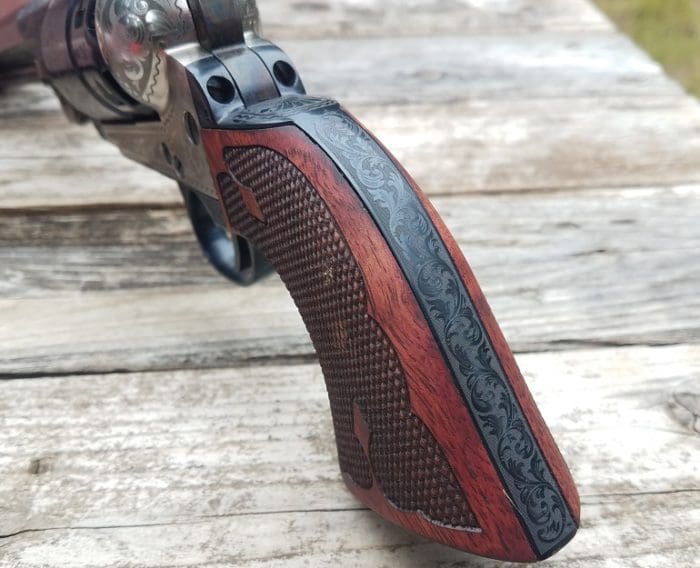
What sold America on the Navy wasn’t the awesome power of that .36 caliber. Although the earlier Colt Dragoons were held in high regard, they were also four-and-half pounds in weight, making them great from the saddle, but too heavy to carry on the belt.
At almost half the weight, the 1851 Navy was the first reliable EDC revolver. People all over the world valued its ease of carry and ease of use over the ballistic advantage of the big .44s. In fact, the only model to outsell it was the five-shot .31 caliber Colt Pocket model, which was less powerful, but even smaller.
Weighing close to the same as a loaded GLOCK 20 or 21, the Navy was light enough to carry on the hip all day long, and many soldiers and lawmen carried at least two. Hence the original name, “Belt Pistol”.

It was easy to carry and easy to shoot. To this day, there isn’t much of anything short of a fully-automatic submachine gun that can get the first two rounds out faster than a Single Action Army.
The 1851 Navy is no different in form that that historic wheelgun. The only difference is the cartridge of the Model P. It’s just perfect to draw, shoot fast and straight, and shoot again. When Charles Dickens visited the London factory, he proclaimed “this could make any fool look like a professional.” It was a perfect balance of weight, speed, ease of use, and powerful enough to get the job done.
The cylinder of the Pietta has the correct engraving of the victory of the Texas Navy over the Mexicans during the Battle of Campeche in 1843. As the nation of Texas had given Sam Colt his first commercial success in their purchase of the Paterson Revolver, he decided to honor that success by engraving the Texas Navy’s victory as standard on the mass produced revolver. It would not be the last time Colt would make good on the friendships he developed with Texas.
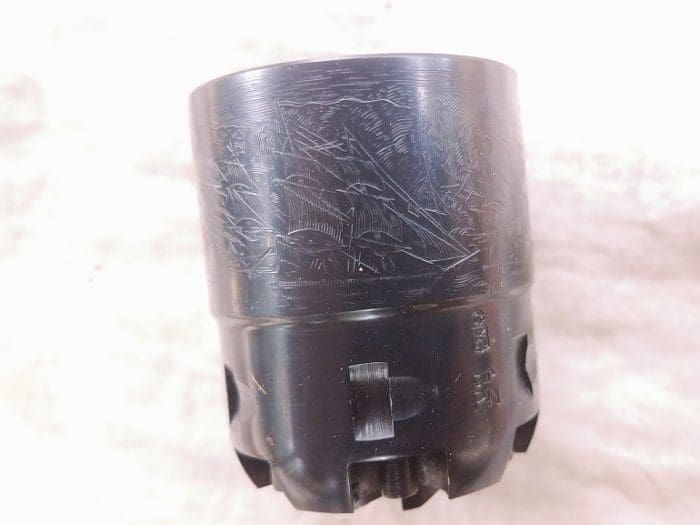
When I first saw the cylinder, I thought it looked more or less like shallow scratches in the metal. It’s certainly not high quality engraving. But it is, in fact, completely authentic. Numerous copies in books look just like the Pietta reproduction. And no wonder, since both the reproduction as well as the originals, as seen below, were not engraved by hand, but by machine.
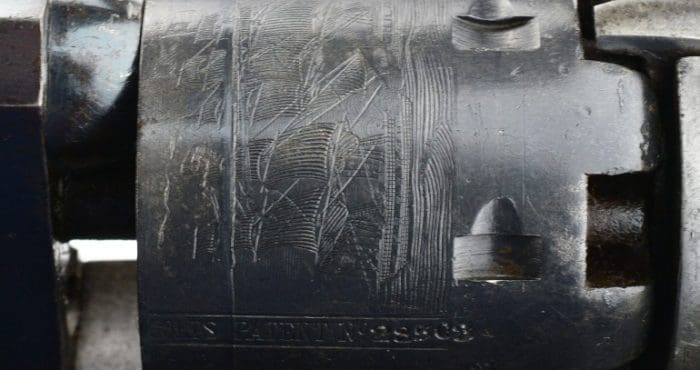
Machine engraving doesn’t have the depth and finesse of hand engraving, and you could certainly get your 1851 Colt hand engraved from the factory with a variety of different prints. But for most of the 1851 Colts, hand engraving wouldn’t be as authentic as machine engraving, because that’s how it was done by the factory.
Mr. Waterman Ornsby, an engraver for Colt, invented the Pantographic Engraving Machine, an automatic engraver that was used on most of the engraved 1851 cylinders. Ornsby’s name is engraved on the Pietta’s cyclinder, just as it was on the original Colts. So when you are holding a machine-engraved reproduction cylinder, you are holding a gun more like the originals than most hand-engraved copies.
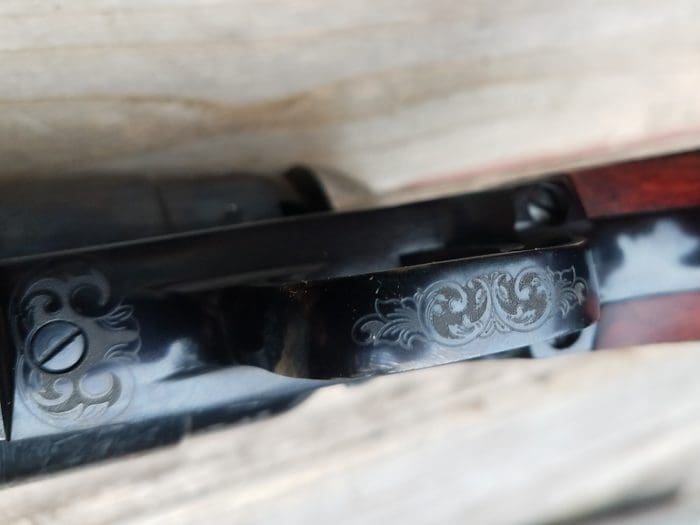
Of course then, as now, you could get the cylinder smooth and unadorned, and the rest of the firearm can be had sans engraving as well. During its original production, there were a few different “standard” engravings to be had on the frame and barrel. Cimarron’s laser-engraved version matches numerous historical examples. There are also several other finishes and styles available from Cimarron.
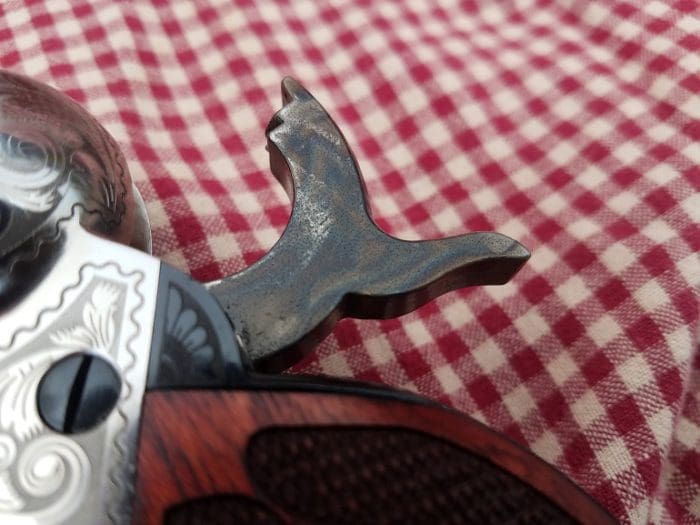
This model is particularly fancy, with laser engraving throughout the entire gun as well as a silver plated frame piece. This version, again, is historically accurate. The modern Gucci GLOCKs have nothing on the selection of adornments available from the Colt factory in the early Navys. Historical examples of this style of embellishment abound. There are several photos of firearms, although in black and white, that appear to almost perfectly mirror this model in Elmer Keith’s writings.
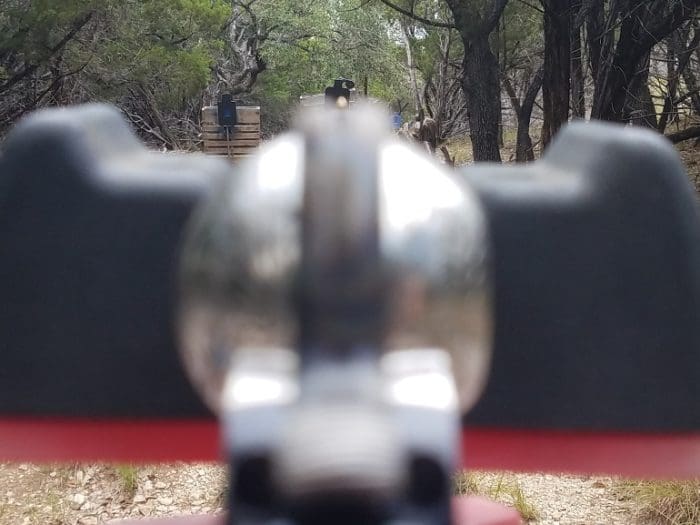
This one has the traditional notched hammer rear sight and a small, sharp brass bead front sight. It also shoots about eight inches high at 25 yards. This is also historically accurate, as many of these guns shot high all the way out to 75 and 80 yards. At close range, they sported a “belly hold,” meaning if you sighted in on a man’s belly button, you were likely to hit him square in the chest.
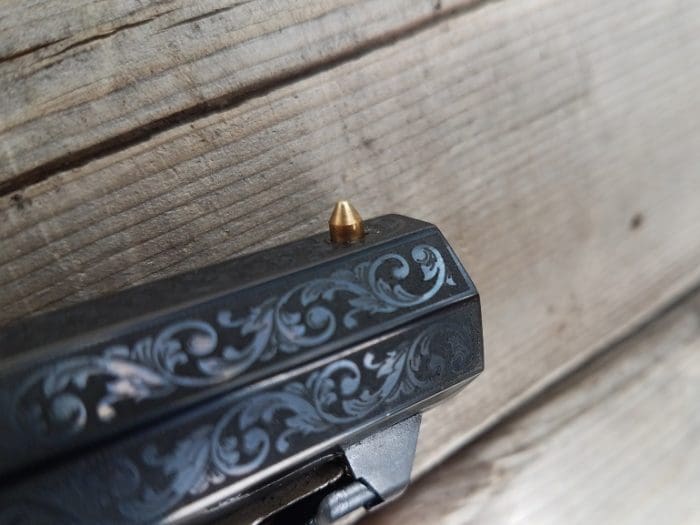
Then, as now, many folks liked a closer zero. This is fairly easily accomplished by simply employing a higher front bead sight. Still, many folks chose to dove-tail a blade front sight into their guns, and a few competitors and afficianados employ that practice today.
The short, single-action trigger breaks at just under two pounds. There is no grit, no creep. Some replicas I’ve shot have unduly heavy triggers, but I haven’t found any like that from Pietta or Uberti, or any of the sixguns I’ve shot from Cimarron.
I find it interesting nowadays that a trigger under three pounds has to be special ordered from most manufacturers, if you can get them to do it at all. That weight would have been considered a little heavy on the guns that made the single action revolver popular.
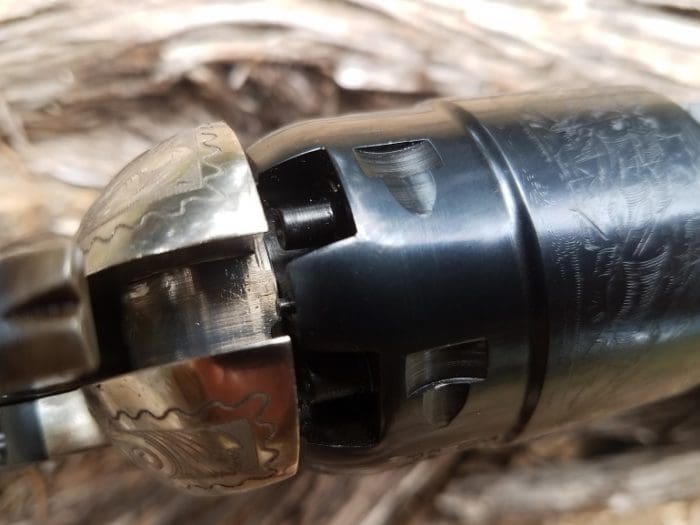
It was also reliable, then and now. I put 50 store-bought Hornady balls through the gun, backed by 25 grains of Goex FFFg powder. I lightly lube my lead balls, but don’t patch them or lube the octagonal barrel. I also put another 50 of my own cast lead balls through the gun with the same powder load, and all using Remington or CCI #10 caps.
After about 20 rounds through the gun, I started having a few failures to fire as the nipples became fouled by the powder. This is, again, similar to the originals. A quick pick of the nipples with a pipe cleaner and they were good to go for another 20 or so shots.
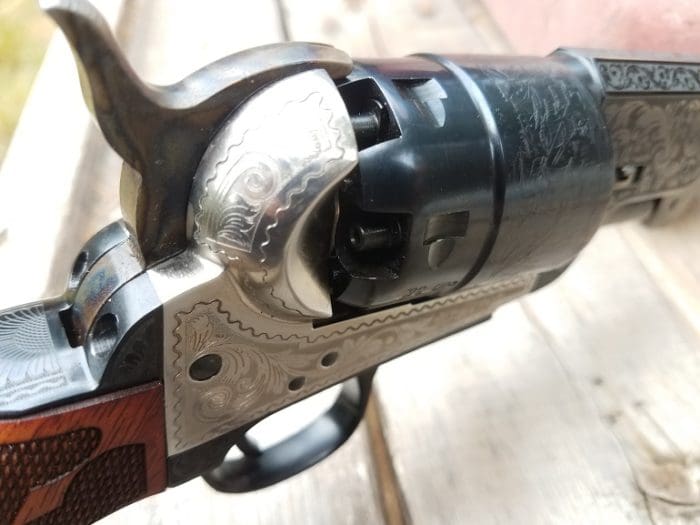
Also like the originals, there were a few times when the caps became slightly dislodged, making the action stick. A firmer hand and harder push down on the hammer did the trick of rotating the cylinder. I never had the action stop because of a cap or any other reason.
Prior to shooting the revolver, I completely disassembled and cleaned it, as per the instructions. The only lube I used on the gun was from a jar of buffalo grease I keep on hand for just such a purpose.
After the first 50 rounds, I scrubbed the bore clean with a nylon brush. That’s the only maintenance, beyond cleaning the nipples, I did to the gun during the entire review. I’ve put another 200 round balls through the Navy since the end of the review period (I bought the gun), without issue.
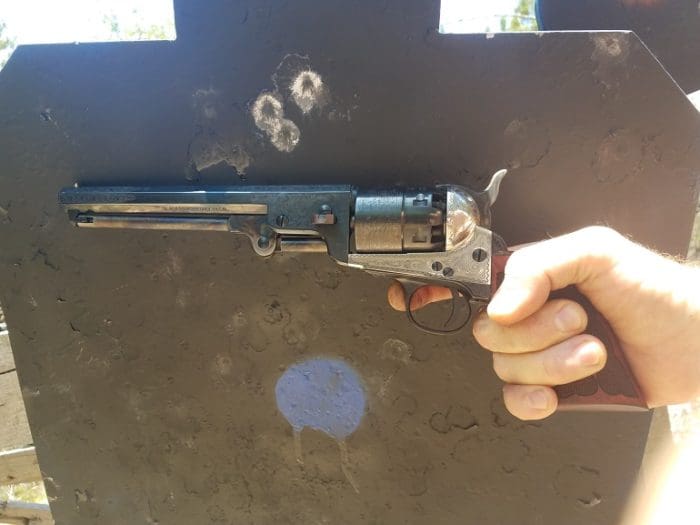
After my last review of the McColloch Colt, I was no longer surprised by the accuracy of the revolver. With a carefully measured 25 grains of powder and the same store-bought .451″ balls, I averaged one-inch, five-round groups at 25 yards from a rest. Many of my three-round groups were significantly smaller. Off-hand is almost as good, as my better three-shot groups, above, hovered around the two-inch mark. That’s about as good as I can shoot off-hand with any pistol.
Were the originals that accurate? Ask Dave Tutt. Except you can’t, because Wild Bill Hickock shot him dead with his Colt Navy at 75 yards away when Tutt missed his shot.

Cimarron sells the 1851 in a variety of finishes and styles, and two calibers. Of course, the .36 caliber model is the historically appropriate choice, but they also offer it in .44, which is the version I’ve chosen. Part of the reason is that I enjoy close-range pig hunting with my black powder guns, but also because I just didn’t want yet another lead ball caliber to add to my .44s, .45s, .50s, .54s and .58s.
Historical purists will be aghast at a .44 Caliber Navy revolver. Oddly enough, if Cimarron would have called it an 1860 Army instead, it might have been more accurate. Many 1860 Armies in .44 were made with the old Navy pattern loading lever and Navy grip frames, yet another testament to the legendary handling of the 1851 Navy revolver.
The 1851 Navy would reign supreme in its use throughout most of the US, and certainly in Texas. It was commonly carried in the Lone Star State until, in in 1875, carpetbagger legislators outlawed the carry of “pistols, dirks, swords, and other personal weapons.” That law was only recently completely repealed. Oddly enough, it was the “dirks and swords” portion that was removed in the last few years, long after the ban on carrying pistols was eliminated in Texas.
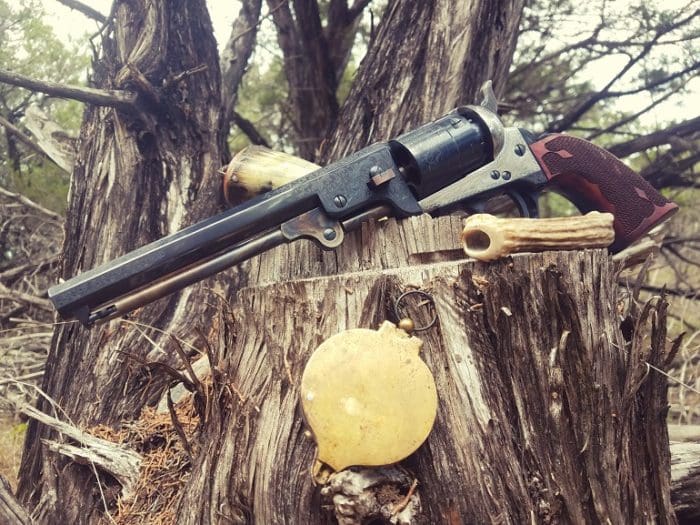
Cimarron has been in the business of designing and importing historically correct replica firearms for decades. They’ve been an integral part of the industry and I haven’t seen anything from them of less than outstanding quality. In working with Pietta, again, they’ve been able to produce a great revolver that’s true to the original. If you haven’t shot an 1851 Navy, I’d highly recommend getting a few cylinders through the Percussion Peacemaker. You won’t regret it.
Specifications: 1851 Navy Engraved
Manufacturer: Pietta
Caliber: .36 or .44
Barrel: 7.5″ Octagonal
Action: Single Action Black Powder
Sights: Fixed notch rear, bead front
Weight: 2.6lbs
Grip: Checkered walnut
MSRP: $422.50
Style and Appearance * * * *
I think I would like the smooth cylinder and case-hardened frame more, as the engraving is mediocre at best. It’s also completely authentic.
Historical Accuracy * * * * 1/2
I can find numerous historical examples of original guns that looked and functioned just like this one. Mine is in the wrong caliber, .44, but the appropriate one can be ordered just as easily. The original barrels and frames obviously weren’t laser engraved, as this one is.
Accuracy * * * * *
One-inch groups or better, just like the originals.
Reliability * * * and * * * * *
Perfectly reliable, given the nature of a black powder revolver. Still, that’s a pretty big qualifier if you were to compare it to cartridge firearms.
Overall * * * * 1/2
This is the gun that swept the nation. The quintessential black powder revolver. Cimarron and Pietta do it justice.
I relied heavily on several books for this review. Of special note were Sixguns by Keith, Percussion Revolvers, and Guns of the Gold Rush.


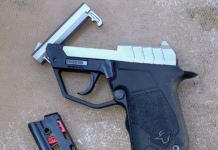
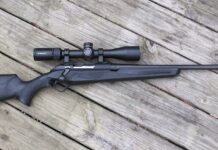
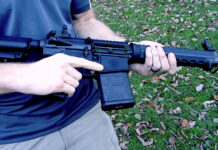
Quite the hand cannon. My dad wants a .44 black powder I’ll consider this one if it can be found without engraving.
You might also try the Navy Arms Company, which also owns (the Old Scrounger and Gibbs Rifle Company) of Martinburg, WV. Or even Cabela’s which sell Reproductions of Said Same…
Several different models available:
https://www.cimarron-firearms.com/products/revolvers/percussion-revolvers-2/1851-1860-1861/1851-navy.html
I own this gun and it’s amazing but you may want to consider the Remington model new Army also, I got one for my dad and it’s a stout revolver that’s beautifully built.
Very interesting. Always enjoy these historical/contemporary articles.
““Navy caliber” refers to .36 caliber ball preferred by the United States Navy.”
No, Navy caliber refers to the caliber the Colt Navy used, nothing to do with what the US Navy used. It was called the Colt Navy because of the Naval battle scene engraved on the cylinder which is a depiction of the Second Texas Navy at the Battle of Campeche. The US Navy bought very few of the the guns.
You are correct in that the US Navy purchased relatively few of these guns, at least in comparison to the army. However, everything I can find says that they didn’t want the already available .44, or the already available .31, but liked the balance of power and light weight of the new .36. Hence the original name, “Revolving Belt Pistol Of Navy Caliber”.
Very very nice.
The South was besieged by carpetbaggers after the war,but I don’t think they ever became state legislators.
How I wish this were not true. But in Texas, about 10% of the legislators in the Constitutional Convention of 1868 were northerner Republicans, and they held significant positions of power. Governor Pease, although he fought for Texas’ Independence, was born in Connecticut, sided with the Union during the war, and was a member of the Republican party. He was appointed to the position of Governor after the Civil War by the US military. Northern Republicans also held the positions of state adjutant general and chief justice of the Supreme Court and 86 of the district court judges were northerners.
“True to the original, it’s…historically accurate…” This is not a correct statement – Colt never made the 1851 Navy revolver in any caliber but .36. The company’s .44 caliber revolvers were the various Dragoon models, and then the 1860 Army. So, the .44 cal 1851 Navy is a liberty taken by the Italian reproduction gun makers. What this .44 cal version does to is put the smaller 1851 grips into the hands of shooters who don’t like the larger 1860 Army grips on a .44 revolver.
I got one of the Colt’s .36 cal 1851 Navy reissues back in the early 1980’s (I also got an 1860 Army then). No difference from the Italian repros (in fact, I was told that Italian companies made the revolvers and they were finished by Colt) except for correct Colt markings in lieu of Italian proof marks and the manufacturer’s names on the various parts. On my pistol, the silver square-back trigger guard was pretty small – I could never have used it with gloves. But it was a blast to shoot – virtually no recoil and reasonably accurate, even with the crude sights. As I recall, Colt originally regulated these revolvers to hit point-of-aim at 25 yards, so the shooter must aim low if closer to the target. When shooting this revolver, I just had to remember to put some water-pump grease on the cylinder pin to keep the cylinder from jamming up from black powder fouling getting into that area. I do that with every cap-and-ball revolver I have and it works.
BTW, I read somewhere that when “Wild Bill” Hickok killed Dave Tutt, he did so with a .44 Dragoon revolver. Any information on this?
I think I made it pretty clear, in multiple locations in the article, that the .36 would be the historically correct caliber.
Even so, your statement that ” Colt never made the 1851 Navy revolver in any caliber but .36.” is not correct. Colt produced a few Navy’s in an experimental .40 caliber, specifically for the US Navy Ordinance Department and they also made some in .34. Very few in those calibers were made. They are worth considerable coin.
As far as Hickock, he carried the Navy, not the Dragoon. There are many historical photos of this, and the eye witness reports are specific that he used a Colt Navy in his shootout with Tutt. It was one of those very rare instances that actually happened like the movies portray.
Somehow while reading this I pictured myself sitting around a fireplace in a cabin, like grandpa telling about the depression…. it was nice.
You should do a fireside chat with Dennis Prager.
I like where this is going…..
JWT – Thanks for the info on the .40 and .34 cal experimental 1851 Navy revolvers. I had not run across that information before (as you may deduce, I am not a hard-core professional researcher), so I learned something new today. Thanks also for clearing up the issue about the revolver Hickok used in his fight with Dave Tutt.
You are welcome sir. I would highly recommended the book Sixguns by Elmer Keith for early revolver history, and The Gunfighters for lots of eye witness accounts and photos of the old school “man killers”.
I have one of these in the standard, non-engraved issue and it’s a really fun gun.
I’ve been warned that if you shoot heavy loads through it, over time the brass frame will stretch, causing the cylinder gap to get larger and larger and making the cylinder lockup looser.
For that reason, since this is just a “fun” gun, I only shoot very light loads through it — 12-15 gr. FFFg.
Supposedly the steel frame Colt Army 1860s and Remington 1858s hold up better to more powerful loads.
Lightest load I’ve seen to date was a 8-mil with a 0.55-grain propellant charge. which barely propelled to bullet out to 300 meters.
These are steel framed guns.
The Frame was made of Brass! The Cylinder and Barrel were made of Steel…
Some were, some were not. These are steel frames. Brass frames are also available.
Your last sentence “Frame was made of BRASS” Exactly what I said. I also said that “Cylinder and Barrel” were made of STEEL, something you “Didn’t” say…
Sich, I don’t understand your point.
Yes, this PARTICULAR gun has a steel frame. Colt NEVER made a brass framed pistol, but the Confederacy did when steel ran low, and those pistols, as was the Whitney, a virtual copy of the 1851. These brass framed repros (Pietta and Uberti both make them) are usually referred to as “brassies,” and I won’t own one. I have four of these guns by three different manufacturers and all have steel frames.
Dag nab it ¡!
I’m at the point where I don’t want any more calibers.
And THEN you whip out this review on a whole new (old(?)) genre of pistols.
I suppose I should surrender to The Borg and just buy in…
‘Cuz it’s hard to say ‘no’ to having fun with guns.
I feel you. I’ve bought every single black powder gun they’ve sent me to review. It’s getting a little ridiculous, even by my standards, which are…ridiculous.
Do you have any flintlock rifles? I’ve got an itch for an old Kentucky or Pennsylvania flint lock and would love to read your thoughts/experience.
Yes, several. I do most of my serious hunting with a flinter.
My wife has a very similar BP revolver. She nagged me until I broke down and bought it for her birthday a few years back. I held very low expectations for the gun–until I shot it for the first time.
Hooked.
So. Much. Fun.
Now I have a Pietta 1851 myself. We load about 25 grains of Triple Se7en (both are steel framed), lubed wad, then the .451 ball. #10 CCI caps work great and seem to fit better then the Winchester #10s.
For those out there that haven’t had the pleasure of this type of BP weapon, be forewarned. You will be instantly hooked.
Great write-up on a really neat gun.
The british army issued very few revolvers at the time of the Crimean war. Officers were expected to buy their own and a brand was not specified. Most enlisted men that were issued a pistol were issued the single shot ‘Tower” smoothbore percussion pistol.
The Colts were issued to Farrier Sergeants of the cavalry regiments. Amongst their many duties these men were expected to put down wounded and injured mounts after a battle and during routine day to day operations.
Balaclava was a horror show in more ways than one.
Awesome!
I purchased one of these for my Christmas present to me last year. I found the engraving to be rather rough to the touch, so I smoothed it out with some 1200 grit wet/dry paper. The “case hardening” on the loading handle and on the hammer is fake–it is just sprayed on. The bluing on the barrel was imperfect. Other than that, and my usual routine of polishing the faces of the hammer where it meets the frame, and verifying that the cam lobe and the cyclinder locks actually fit together (often they don’t), it is a very nice pistol.
To the author: the engraving on the cylinder is a roll engraving, by which the cylinder is pressed against a die to make the marking. Second, your 25 grains is somewhat light for a .44; most of the Army pistols are loaded to 28-30 grains.Another way to adjust the sights is to deepen the slot V in the hammer with a file. Or for closer range shooting, aim along the barrel instead of using the sights.
The .44 cal Army was built on a modified Navy frame with a longer grip frame that was part steel and part brass. They front part of the cylinder was widened to accept that larger ball, but the rear of the cylinder remained the same as the Navy, thus allowing all the clock work to remain unchanged. The original Colts were drilled to .44 up until the transition in the cylinder, and .36 to the bottom of the bore.The .44s could be loaded to about the same power load as the later 1873 in .45 Colt, i.e. 35-37 grains. (The 1873s were rated for 40 grains, same as the .44-40, but were down loaded to 35 or 30 grains to reduce recoil.)
Great review! Looks very fun! Feeling like I should buy one (and just when I was cutting back…)
Julian – You can’t get away with just buying a cap-and-ball revolver – you also gotta buy a flask, maybe a cap box or a capper, a mould for casting ball or conical bullets, a nipple wrench and maybe a case to store it all in. Oh, and a holster – gotta have that! It can run into a little extra money besides what you spend on the revolver itself. But that’s the fun of it – it never stops.
I got a couple of cheap Italian bp revolvers in the late 70’s when ever Kmart and meijers store had them .
(at least in northern Indiana) they were loads of fun. in his book “sixguns” Elmer Keith said the preferred way to load them was to fill the cyl with powder until the ball just fit on it. He said that the old civil war veterans he talked to swore it was a great stopper. he also said the round ball stopped better than the conical bullets.
all I know is they were great cheap fun. They would do a real number on the garden eating groundhogs too.
@ GS650G.
The “Sportsmans Guide.com” is offering a Uberti Reproduction Model 1847 Colt Walker .44-caliber Plack Powder for $386.99 Member Price or $429.99 Non-Member Price. Item Number is #2078-593835, sale is good through 5 August 2018 if your interested…
Great review, well done. Good and informative comments also. Thanks
I’m really enjoying the black powder articles that have been popping up lately.
I ordered a Uberti Navy 51 London Navy from Sportsman’s Guide when they had their 20% off sale around Christmas. It’s a beautiful gun.
I still haven’t shot it yet. I need to get some caps along with a flask for it. I picked up some BP & Round Balls from Graf’s on the last order. It was kinda hard to find anyone that carried black powder and I didn’t want to use Pyrodex my first time shooting a BP gun.
you might try:
1. DuPont of Wilmington, Delaware, or
2. Hazzard Powder Co. of Enfield, Conn., or
3. Latine, Smith and Boies of Saugeties, NY., or
4. Oriental Gunpowder of Boston, Mass., or
5. Schaghticoke Gunpowder of Schaghticoke, NY.
…
I know this website gives quality dependent posts and extra material,
is there any other web site which provides these kinds of stuff in quality?
Greate post. Keep posting such kind of info on your
page. Im really impressed by your blog.
Hello there, You have done a fantastic job. I will certainly digg
it and for my part recommend to my friends.
I’m sure they will be benefited from this website.
I’ve come across one of these engraved models and was researching to make sure of what metal is used in its construction. Particularly the frame. I’m only interested in steel and this appears to be steel with a silver colored/nickel plating. I assume all of the blue/black parts are steel too?
Nice article, makes interesting reading.
BTW, in your first sentence it’s effect, not affect.
If you love to wear vests? so get this amazing Red Puffer Vest which is a favorite of all girls and it is the most-rated and most selling outfit in our store, shop now because the stock is limited.
Comments are closed.